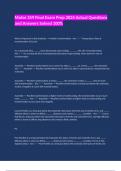Matse 2 - Study guides, Class notes & Summaries
Looking for the best study guides, study notes and summaries about Matse 2? On this page you'll find 66 study documents about Matse 2.
All 66 results
Sort by
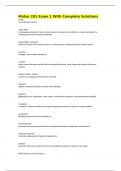
-
Matse 201 Exam 1 With Complete Solutions
- Exam (elaborations) • 11 pages • 2024
-
- $10.19
- + learn more
Matse 201 Exam 1 With Complete Solutions metals most elements exist as metal alloys a homogenous mixture of two or more elements at least one of which is a metal, and where the resulting material has metallic properties intermetallic compound similar to alloy but the mixture exists as a stoichiometric compound (distinct atomic ratios) ceramics inorganic, non-metallic substances ceramics solids formed between metallic and nonmetallic elements, most frequently oxides nitr...
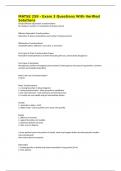
-
MATSE 259 - Exam 3 Questions With Verified Solutions
- Exam (elaborations) • 10 pages • 2024
-
- $10.59
- + learn more
MATSE 259 - Exam 3 Questions With Verified Solutions Simple Diffusion Dependent Transformations No change in number or composition of phases present Diffusion Dependent Transformations Alterations in phase compositions and number of phases present Diffusionless Transformations metastable phase, diffusion is very slow, a new phase Two Types of Phase Transformation Stages Nucleation (small particles) & Growth (increasing the size, parent phase disappears) Two Types of Nucl...
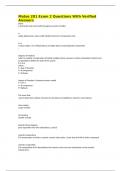
-
Matse 201 Exam 2 Questions With Verified Answers
- Exam (elaborations) • 5 pages • 2024
-
- $10.09
- + learn more
Matse 201 Exam 2 Questions With Verified Answers phase a chemically and structurally homogenous state of matter α single alpha phase; where solid solution between 2 components exist L+ α 2 phase region, mix of liquid phase and alpha phase containing both components ; Degrees of freedom refers to number of externally controlled variables( temp, pressure, system composition) which must be specified to define the state of the system F=C-P+2 where .. F= deg. of freedom C= ...
Matse 259 Final Exam Prep 2024 Actual Questions and Answers Solved 100%
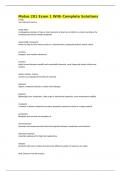
-
Matse 201 Exam 1 With Complete Solutions
- Exam (elaborations) • 11 pages • 2024
-
- $10.99
- + learn more
Matse 201 Exam 1 With Complete Solutions metals most elements exist as metal alloys a homogenous mixture of two or more elements at least one of which is a metal, and where the resulting material has metallic properties intermetallic compound similar to alloy but the mixture exists as a stoichiometric compound (distinct atomic ratios) ceramics inorganic, non-metallic substances ceramics solids formed between metallic and nonmetallic elements, most frequently oxides nitr...
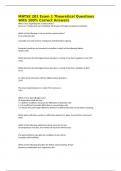
-
MATSE 201 Exam 1 Theoretical Questions With 100% Correct Answers
- Exam (elaborations) • 7 pages • 2024
-
- $10.29
- + learn more
MATSE 201 Exam 1 Theoretical Questions With 100% Correct Answers What is true regarding the crystal systems? there are 7 shapes that can completely fill 3D space through translational symmetry Which of the following is not one of the crystal systems? Face centered cubic examples of crystal systems: tetragonal, rhombohedral, trigonal Elemental metals do not commonly crystallize in which of the following lattices Simple cubic Which direction has the highest linear density in ...
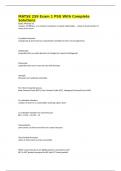
-
MATSE 259 Exam 1 PSU With Complete Solutions
- Exam (elaborations) • 10 pages • 2024
-
- $10.89
- + learn more
MATSE 259 Exam 1 PSU With Complete Solutions Elastic Modulus (e) measure of stiffness, or a material's resistance to elastic deformation ... slope of elastic portion of stress-strain curve Crystalline Materials small group of atoms that are repeated by translation to form 3-D arrangements Antisotropic properties that vary with direction. Ex: E(edge) isn't equal to E(diagonal) Polycrystal properties that may or may not vary with direction Isotropic the grains a...
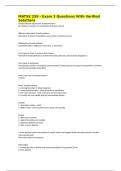
-
MATSE 259 - Exam 3 Questions With Verified Solutions
- Exam (elaborations) • 10 pages • 2024
-
- $10.89
- + learn more
MATSE 259 - Exam 3 Questions With Verified Solutions Simple Diffusion Dependent Transformations No change in number or composition of phases present Diffusion Dependent Transformations Alterations in phase compositions and number of phases present Diffusionless Transformations metastable phase, diffusion is very slow, a new phase Two Types of Phase Transformation Stages Nucleation (small particles) & Growth (increasing the size, parent phase disappears) Two Types of Nucl...
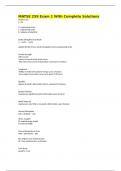
-
MATSE 259 Exam 1 With Complete Solutions
- Exam (elaborations) • 7 pages • 2024
-
- $10.69
- + learn more
MATSE 259 Exam 1 With Complete Solutions Hooke's Law σ = Eε σ: engineering stress ε: engineering strain E: modulus of elasticity Elastic Elongation and Strain v = -εx/εz = -εy/εz applied tensile stress, elastic elongation and accompanying strain Tensile Strength (MPa or psi) -Stress at max of stress-strain curve -Max stress that can be sustained by a structure in tension Toughness -Ability of material to absorb energy up to a fracture -Area under stress-st...
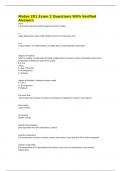
-
Matse 201 Exam 2 Questions With Verified Answers
- Exam (elaborations) • 5 pages • 2024
-
- $10.49
- + learn more
Matse 201 Exam 2 Questions With Verified Answers phase a chemically and structurally homogenous state of matter α single alpha phase; where solid solution between 2 components exist L+ α 2 phase region, mix of liquid phase and alpha phase containing both components ; Degrees of freedom refers to number of externally controlled variables( temp, pressure, system composition) which must be specified to define the state of the system F=C-P+2 where .. F= deg. of freedom C= ...

$6.50 for your textbook summary multiplied by 100 fellow students... Do the math: that's a lot of money! Don't be a thief of your own wallet and start uploading yours now. Discover all about earning on Stuvia

